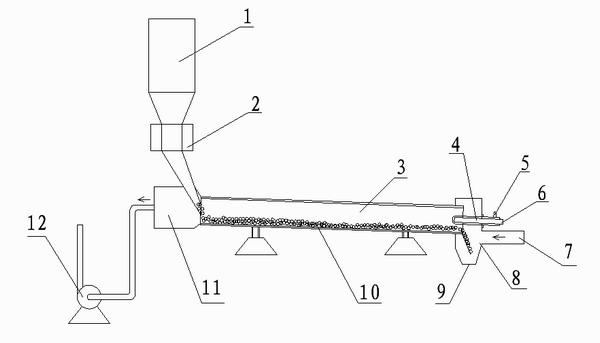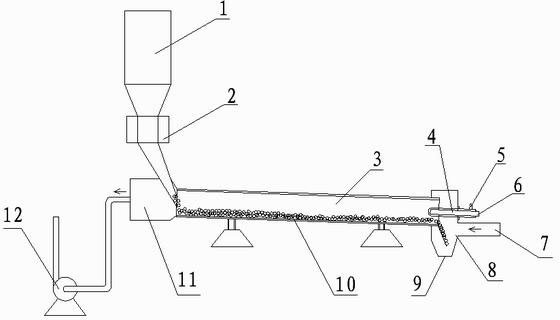Presintering treatment process of glass batch and device thereof
A technology of glass batch materials and processing technology, applied in glass manufacturing equipment, glass production, manufacturing tools, etc., can solve the problems of increasing the difficulty of breaking, discontinuous production process, etc., to reduce energy consumption, increase single-line output, and increase heat the effect of transmission
- Summary
- Abstract
- Description
- Claims
- Application Information
AI Technical Summary
Problems solved by technology
Method used
Image
Examples
Embodiment 1
[0025] like figure 1 As shown, a device for decomposing glass batch materials outside a carbonate melting furnace - a rotary heating furnace, which includes a feeding device 2, a rotary heating cylinder 3 with an inclination angle of 3 to 12° from the horizontal, and a kiln head sealing device 8 , kiln tail sealing device 11 and burner 4;
[0026] The upper end of the feeding device 2 is provided with a storage bin 1, and the lower end is connected with a kiln tail sealing device 11;
[0027] The high end and the low end of the rotary heating cylinder 3 are respectively sealed and connected with the kiln tail sealing device 11 and the kiln head sealing device 8, and one end of the kiln tail sealing device 11 is connected with the inlet of the high-temperature induced draft fan 12, and the kiln head The sealing device 8 is provided with a flue gas inlet 7 and a spherical pellet outlet 9;
[0028] The burner 4 extends into the rotary heating cylinder 3 through the kiln head se...
Embodiment 2
[0037] The difference with embodiment 1 is:
[0038] (1) Dissolve water glass accounting for 1.5wt% of the glass batch material in water accounting for 8wt.% of the glass batch material, then mix the above water glass solution into the glass batch material, mix well, and use a semicircular concave surface on the surface Press it into spherical pellets of 5~18mm by pair of rollers.
[0039] (2) Put the spherical pellets into the rotary heating furnace and pre-fire at 1180~1250°C, and the sintered and compacted spherical pellets are fed into the glass melting furnace from the outlet of the rotary heating furnace.
[0040] Since the pellets compressed into a spherical shape are 5-18mm in size, the pre-calcination and decomposition time in the rotary heating cylinder is about 1 hour.
[0041] Water glass described in the present embodiment can also be replaced with methyl cellulose.
Embodiment 3
[0043] The difference from Example 1 is:
[0044] (1) Dissolve water glass that accounts for 3wt.% of the glass batch in hot water (80-100°C) that accounts for 7wt.% of the glass batch, then mix the above water glass solution into the glass batch, mix well, It is pressed into spherical pellets of 8~25mm using a pair of rollers with a semicircular concave surface.
[0045] (2) Add the spherical pellets into the rotary heating furnace, pre-fire at 1020~1150°C, and add the sintered and densified spherical pellets to the glass melting furnace from the outlet of the rotary heating furnace.
[0046] Since the pellets pressed into spherical shape are 8~25mm, the pre-fired decomposition time in the rotary heating cylinder is about 1.5 hours. In this example, three sets of the devices described in Example 1 are used to simultaneously pre-fire the glass batch.
[0047] The water glass described in this embodiment can also be replaced by methyl cellulose.
PUM
| Property | Measurement | Unit |
|---|---|---|
| length | aaaaa | aaaaa |
| compressive strength | aaaaa | aaaaa |
Abstract
Description
Claims
Application Information
 Login to View More
Login to View More - R&D
- Intellectual Property
- Life Sciences
- Materials
- Tech Scout
- Unparalleled Data Quality
- Higher Quality Content
- 60% Fewer Hallucinations
Browse by: Latest US Patents, China's latest patents, Technical Efficacy Thesaurus, Application Domain, Technology Topic, Popular Technical Reports.
© 2025 PatSnap. All rights reserved.Legal|Privacy policy|Modern Slavery Act Transparency Statement|Sitemap|About US| Contact US: help@patsnap.com


